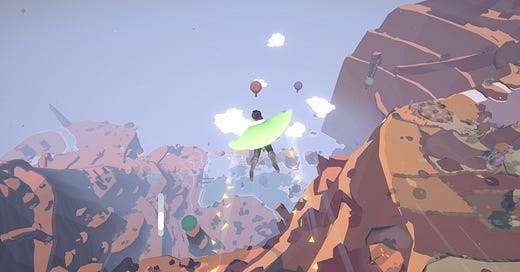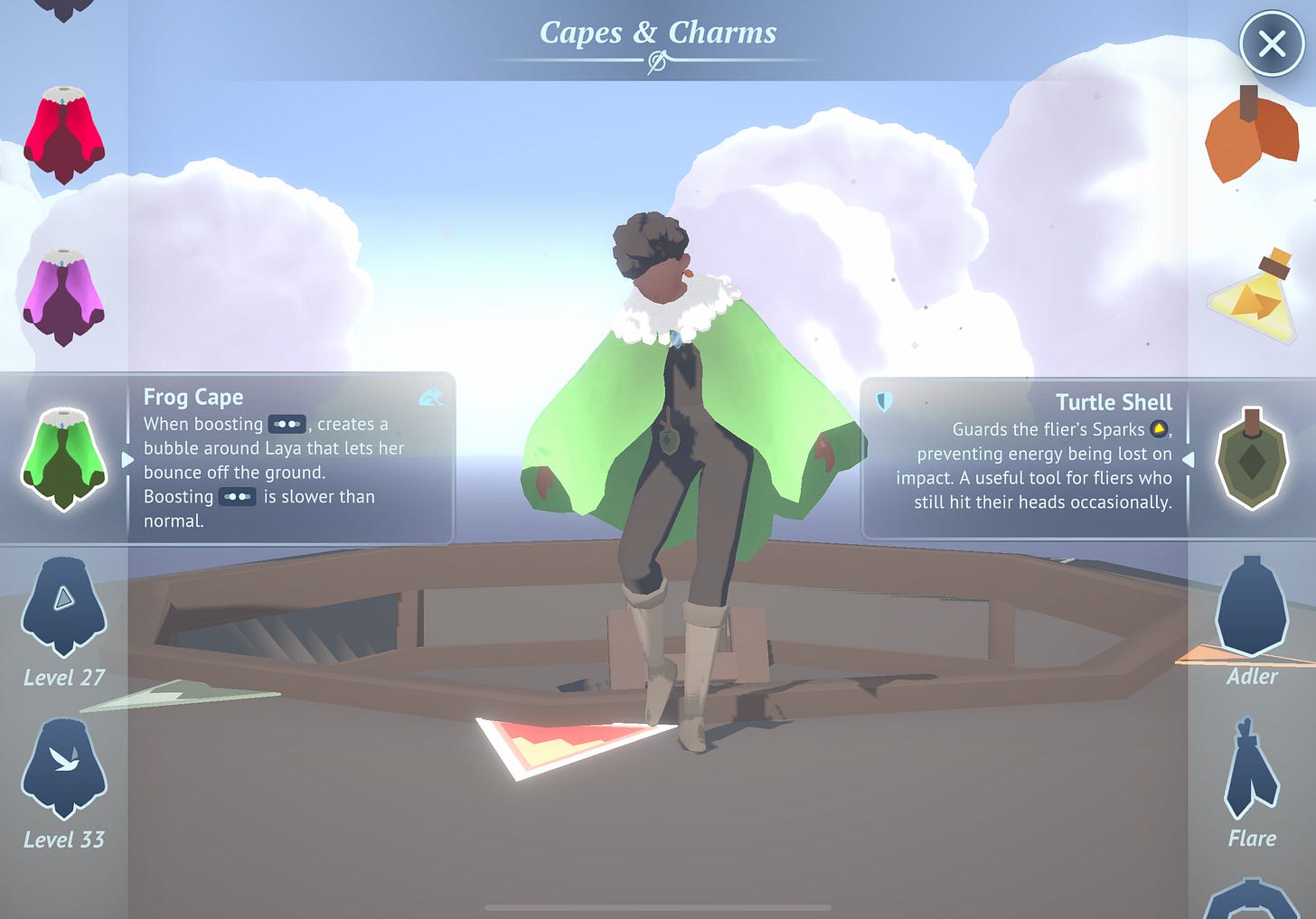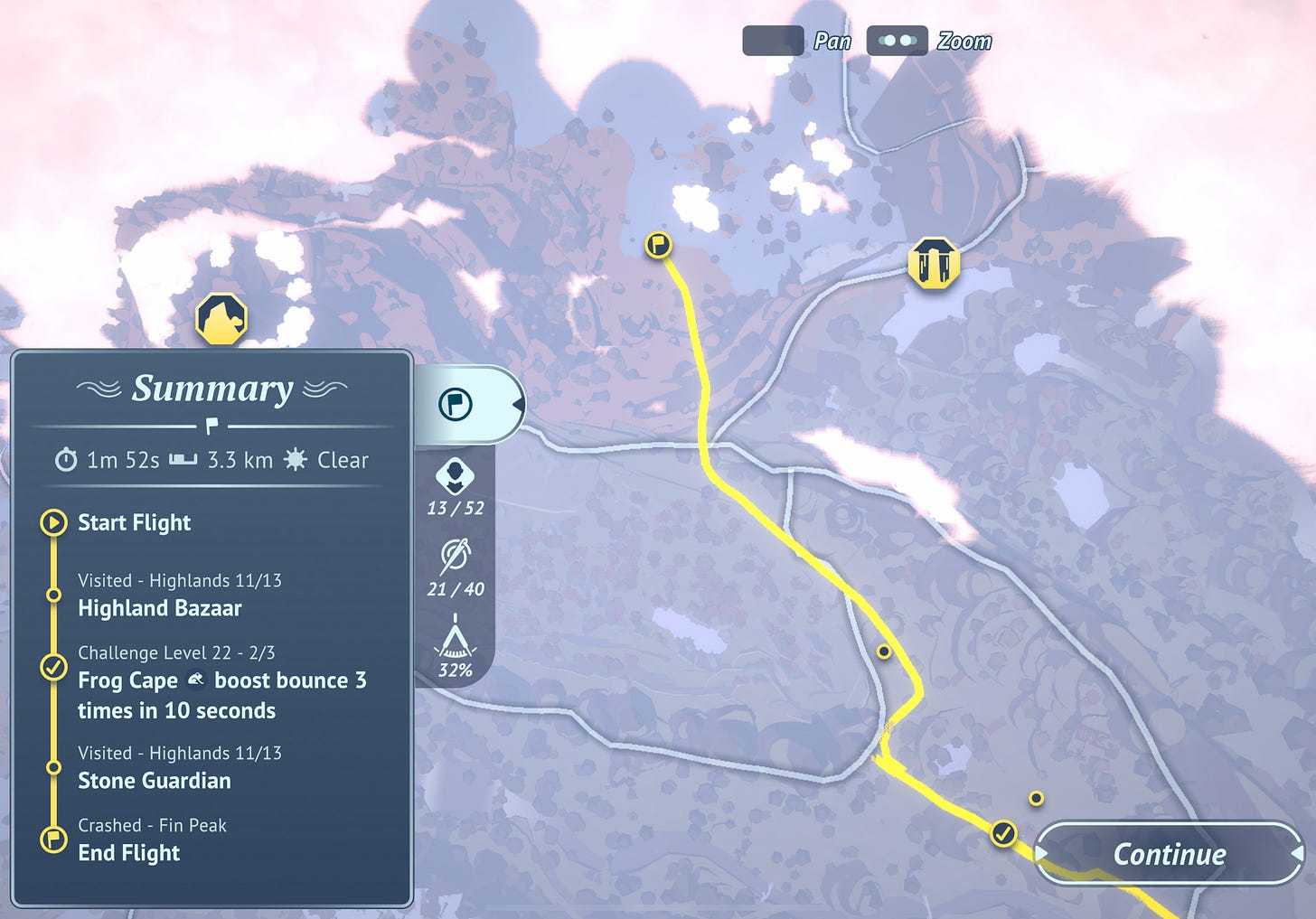iOS, Android
Free via Netflix
Unlimited
Laya’s Horizon is a 3D flying wingsuit game where you glide down a mountain packed with charming vistas, eventually landing (or crashing) by the shore. You can boost your speed and altitude by flying into updrafts, wind tunnels, geysers, and bouncing off hot air balloons; but the main way is by collecting “sparks”, which fuel your boost ability.
Sparks are liberally scattered along rivers, tunnels, and down cliffs. You can also automatically collect sparks by performing “tricks” such as flying close to the ground or along the water. Basically, Laya’s Horizon does everything to encourage you to fly in interesting ways rather than serenely gliding above it all (though that’s also fine).
The game adds structure to your flying in two ways. The first is by unlocking new wingsuit capes every few levels; you level up by completing three challenges per level, like flying near 20 trees in a single run, flying through a windmill, or boosting three times in 30 seconds. Different capes might increase your turning speed and your descent speed, or let you bounce off the ground if you boost into it.
Then there’s the missions offered by “windfolk”. You meet them by landing at highlighted locations and perches, and landing is simply a matter of passing through a coloured sphere surrounding the location. Missions include 2-4 person races; reaching a location while collecting at least 50 sparks; chasing birds; or simply following another windfolk. To make things more interesting, you’re typically required to pass through a few checkpoints on your way. Completing missions can unlock charms that make flying easier, such as the Turtle Shell that protects your sparks from being lost on collisions.
There’s plenty of variation in the levelling-up challenges, such as flying near a wave or passing by ten different species of tree, but ultimately it’s all about flying to interesting places. And that’s why Laya’s Horizon works – because its flying is utterly joyful. The game is 100% skill-based with no luck or random chance whatsoever, but it manages to feel simultaneously welcoming while retaining challenge.
Sure, it encourages you to pull off tricks that are likely to end up in collisions, but your first collision merely bounces you back rather than ends your flight; and if you stay out of trouble for a few seconds, your wingsuit “shield” will restore and you can collide yet again. Lead designer Jesse Baker has talked about adding an ‘air cushion’ which pushes you off the ground temporarily while close, but I never felt like I was being coddled; it just made me take more risks.
Every flight begins at a perch. There are a few of these throughout the mountain that you unlock by landing on them once, and while you’re on them, markers for new missions are highlighted. This is pretty much the busiest the screen gets, because while you’re flying the icons are far fewer and more muted; it’ll show you interesting locations when you get close, but the game really tries to avoid distracting you, sometimes to a fault: I got stuck on an early challenge to fly past someone’s house when I didn’t notice a subtle label directing me there.
The controls can also be tough. Laya’s Horizon is a touchscreen-only game; you place your thumbs on either side of the screen and slide them up and down to tilt, climb, and dive; and to boost you slide them together. Whether due to unclear animations or laggy thumb tracking, triggering my boost or diving felt unreliable and sometimes I couldn’t tell when it was happening. Still, I respect the desire for simplicity, even if I think a boost button would’ve been a bit easier on players.
Another technical limitation means that starting a new flight after a landing or crash takes longer than I like. Part of this comes from the mandatory flight summary that draws your route and milestone; and part is probably me expecting too much from mobile and tablet hardware. Regardless, I felt somewhat punished for attempting hard tricks and challenges because I’d need to wait a little while to try again after crashing.
The music shifts nicely between styles when you cross between regions like the Highlands and Stone Forest, but it often sounds distractingly like Austin Wintory’s score for Journey. The art direction is quite similar, too.
But the game I’m most reminded of is Pilotwings 64 – specifically its Birdman mode, where you’re free to explore the world at leisure. That birdsuit had wings you could flap to climb, unlike your cape in Laya’s Horizon that can only glide, but otherwise the sense of sheer pleasure is the same, if not better.
Designing flight mechanics with precisely the right balance of ease and control demands an unspeakable level of iteration and polish (e.g. the air cushion). And that’s just the start, because the entire world and challenges and missions, even the placement of individual sparks, has to be done by hand. I’m pretty sure there are no procedurally-generation missions in the entire game, and even if procedural generation was used to model some regions of the mountain, it still feels lovingly specific.
This is what we expect from “premium” mobile games, which is to say games that you pay for just once, rather than “freemium” games that badger you to buy coins to upgrade your cape and endlessly unlock new areas and missions. Laya’s Horizon only feels unusual because premium games went more or less extinct thanks in large part to Apple and Google’s deliberate neglect – they make more money by taking their 30% cut from more exploitative games.
But thanks to the new game subscription libraries from Netflix and (sigh) Apple Arcade we may be seeing a renaissance, since they give players a chance to try out new titles at little risk. It’s true for me: I only tried Laya’s Horizon because I’d resubscribed to Netflix for Oxenfree 2.







